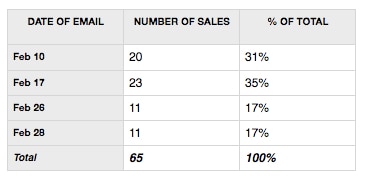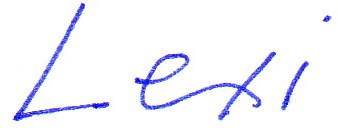In this blog post, I'm going to show you a case study which demonstrates the power of following up on your prospects.
My client decided to have a one-month promotion on his product. He would offer his product at 50% discount, because he was to stop selling it after the promo period.
Our primary means of promoting the sale was through his list. He had a very small list — about 1,000 subscribers before the promo began — with about 100 added during the promo period.
He also has a blog, but with very little traffic. We didn't hope to make a significant number of sales through it.
I created a series of promotional emails to go out to his list subscribers. We sent the first two emails one week apart, followed by a purely informational and pitch-free email. The last two emails were sent three days before the deadline and on the day of the deadline itself.
The final solo email alerted his subscribers that they only had until midnight to purchase the product, or it would not be available anymore.
My client was very hesitant to send this final notice. He was worried that he was marketing “too hard,” and that his subscribers would complain or even unsubscribe.
I reassured him that he was doing his subscribers a service by doing everything he could to make sure those who were interested in the product would be able to purchase it while it was still available and at a significant discount at that.
It's clear that the emails, including each subsequent follow-up, brought in a wave of sales, as this table shows:







The gross amount of the sales was more than quadruple the amount my client thought he would make when we were planning the campaign.
A total of 11 sales were made after the very last email, which would have been lost had my client not listened to me. (He was very wise to allow me to give him advice.)
Were his subscribers annoyed at the nearly weekly reminders about the promo?
In fact, two subscribers, after receiving reminder emails, replied to say that they had already purchased the product (unfortunately, my client's autoresponder service didn't allow me to remove buyers from the prospects lists). I don't consider that a complaint, and they didn't unsubscribe from the list.
My client, in fact, received a letter of gratitude from a customer who bought the product on the very last day. I can't quote the letter here for privacy reasons, but the email said something like:
“Thank you for your reminders. I saw your previous emails but hadn't gotten around to reading them. Thanks to your final reminder, I was able to buy the product before the deadline.”
You bet my client is now convinced that following up is crucial in a promotion!
Have you ever had a similar promotional campaign that involved sending a series of messages to the same readers? What results did you have?
Or do you have a campaign that you think would have benefited from effective follow-up messages?
I'd love to hear about your experience.

![]() photo credit: Mzelle Biscotte
photo credit: Mzelle Biscotte
Lexi Rodrigo is a communication and marketing professional for multimillion-dollar businesses, co-author of Blog Post Ideas: 21 Proven Ways to Create Compelling Content and Kiss Writer's Block Goodbye, and host of "Marketing Insights LIVE!." Connect with Lexi on Twitter, Facebook, or LinkedIn.
Session expired
Please log in again. The login page will open in a new tab. After logging in you can close it and return to this page.
Thanks for sharing Lexi. Follow-up is very important. I wouldn’t do a promo without follow up. It’s so easy to do and can increase revenues from a promotion considerably.
@Alice – Definitely! Glad I learned from the best marketers 😉
Awesome post Lexi. It is very easy to forget to follow-up. I am guilty of this. Most times – I would just send an email twice and then – that’s it (Cause I don’t want to be pushy) … but … in other cases where I continued to sell a product – I have done well. I realize now how “Planning is the key”.
Oh yes, Marie, you need to map out your messages in advance. This helps you to be coherent and consistent in your messaging. It’s also good to keep your “pushiness” in check. Thanks for sharing!
I use constant follow-ups for me and my clients. Last time one of my clients had amazing results, where the last follow-up pulled in almost 3x times more sales than in the first e-mail 🙂
Do you have a specific follow-up sequence you’re following when doing e-mail promos?
I know some folks advise we send at least 7 e-mails; what about you?
Hi @Codrut, I don’t have a “formula.” I plan the emails with my clients to see what’s appropriate for their promo, readers, and personal style.
Off the top of my head, I find 7 emails a bit too many — however, it really depends. For instance, if you have a long promo period, then 7 may be ok. I’ll have to give this more thought. Thanks!
Hi Lexi,
I need to learn to do this. I don’t really ever send anything promotional to my subscribers except for 2 sales that I throw a year. When I make new products I don’t get any response.
Need to start working on better email messages.
Hi Dawn! The problem with having regular sales is that you train your subscribers to wait until you have a sale before they buy something. I know that I behave the same way with certain experts I follow. Even if I want a certain product of theirs, I don’t buy it right away. Instead, I wait for them to announce a sale. So only have a sale when it’s really warranted — such as in my client’s case where the product won’t be available anymore at any price — after the sale period. As for new products, you can try offering early-bird bonuses with a deadline. Send at least 3 emails about this. Remember, people don’t usually buy the first time they see your sales page, so you have to keep reminding them and giving them a reason to visit again. Hope you’ll get results next time!